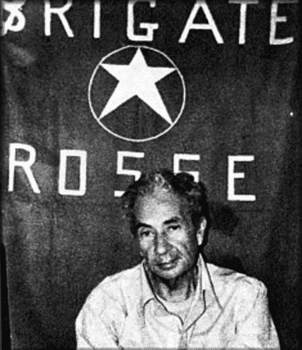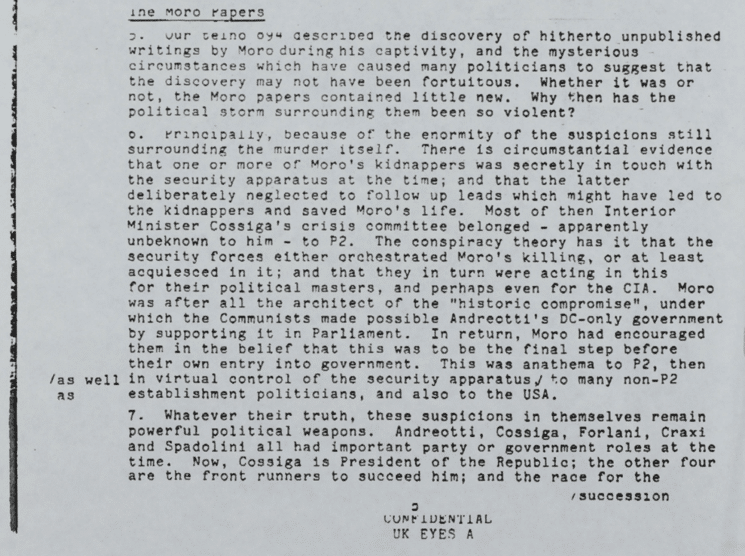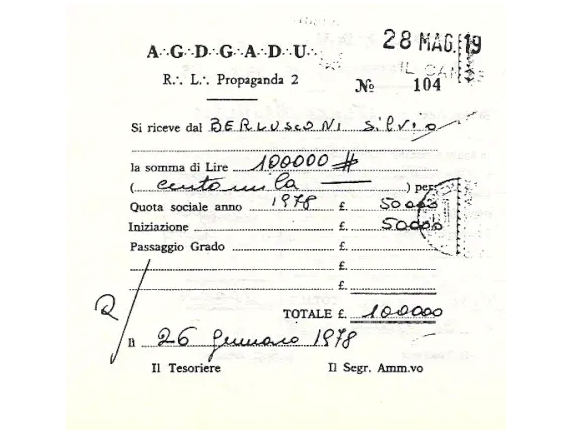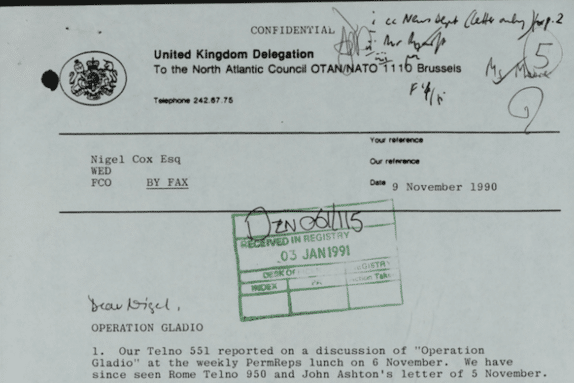Newly declassified British Foreign Office files have added disturbing details to the history of Operation Gladio. The covert operation was uncovered in 1990, when the public learned that the CIA, MI6 and NATO trained and directed an underground army of fascist paramilitary units across Europe, deploying its assets to undermine political opponents, including through false flag terror attacks.
Among them was a young Silvio Berlusconi, the media oligarch who served as Italian Prime Minister in four separate governments between 1994 and 2011. Listed as a member of the P2, the secret Cold War-era cabal of political elites devoted to Gladio’s aims, Berlusconi undoubtedly took some weighty secrets to the grave when he died this June 12th.
It is almost impossible to believe that inconvenient truths were not weeded from Britain’s documentary record on Operation Gladio prior to declassification. Nonetheless, the recently released material is highly illuminating. Covering a fraught twelve month period after the first public disclosure of Gladio’s existence, the papers illustrate how London’s foreign intelligence apparatus kept a keen eye on the continent as events unfolded.
The papers not only shed fresh light on the conspiracy, they underline Gladio’s relevance as British intelligence joins its America counterparts in contemporary plots involving secret partisan forces from Syria to Ukraine.
Various passages dotted across the tranche strongly suggest the British knew much more than they publicly admitted about egregious criminal deeds, including the attempted overthrow of an allied Italian government and the kidnap and murder of its leader.
A ‘clandestine resistance network’ goes to work
Gladio consisted of a constellation of “stay behind” anti-communist partisan armies whose ostensible mission was to fend off the Red Army in the event of Soviet invasion. In reality, these forces committed countless violent and criminal acts as part of a “strategy of tension” designed to discredit the left and justify a security state clampdown.
As Vincenzo Vinciguerra, a Gladio operative jailed for life in 1984 for a car bombing in Italy that killed three police officers and injured two, explained:
You were supposed to attack civilians, women, children, innocent people from outside the political arena. The reason was simple, force the public to turn to the state and ask for greater security… People would willingly trade their freedom for the security of being able to walk the streets, go on trains or enter a bank. This was the political logic behind the bombings. They remain unpunished because the state cannot condemn itself.
The scandal triggered in Western capitals by the exposure of Gladio dominated mainstream headlines for months. The European parliament responded by passing a resolution condemning the existence of a “clandestine parallel intelligence and armed operations organization [which] escaped all democratic controls, may have interfered illegally in the internal political affairs of member states [and] have at their disposal independent arsenals and military resources… thereby jeopardizing the democratic structures of the countries in which they are operating.”
The resolution called for independent judicial and parliamentary investigations into Gladio in every European state. But aside from inquiries in Belgium, Italy, and Switzerland, nothing of substance materialized. What’s more, investigators heavily redacted their findings while avoiding having them translated them into English. This may help explain why the historic scandal has been largely forgotten.
In this context, the newly declassified documents may be one of the most valuable primary sources to date offering new insights into the origins and internal workings of NATO’s secret terror militias in Italy.
Take for example an aide-mémoire (see it here) prepared by Francesco Fulci, Italy’s permanent representative to the UN, which was shared at a “super-restricted” November 6th 1990 meeting of the North Atlantic Council, NATO’s principal political decision-making body, then forwarded to senior British officials at home and abroad.
Based on a note provided by Rome’s then-premier Giulio Andreotti to “the Head of the Italian Parliamentary Commission investigating terrorist incidents,” the aide-mémoire begins by noting that following World War II, Western intelligence agencies devised “unconventional means of defence, by creating in their territories a hidden network of resistance aimed at operating, in case of enemy occupation, through information gathering, sabotage, propaganda and guerrilla warfare.”
According to the aide-mémoire, authorities in Rome began laying the foundations of such an organization in 1951. Four years later, Italian Military Intelligence (SIFAR) and “a corresponding allied service”—a reference to the CIA—then formally agreed on the organization and the activities of a “post-occupation clandestine network”:
[Gladio] was; formed by agents active in the territory who, by virtue of their age, sex and activities, could reasonably avoid eventual deportation and-imprisonment by the foreign occupiers; easy to manage even from a command structure outside the occupied territory; at a top secret level and hence subdivided into ‘cells’ so as to minimize any possible damage caused by defections, accidents or network penetration.
The “clandestine resistance network” was subdivided into separate branches, covering information operations, sabotage, propaganda, radio communications, cypher, reception and evacuation of people and equipment. Each of these structures was to operate autonomously,
with liaison and coordination ensured by an external base.
SIFAR established a dedicated, secret section to recruit and train Gladio operatives. Meanwhile, it maintained five “ready deployment guerrilla units in areas of special interest” across Italy which awaited activation on a continuous basis.
“Operational materials”, including a wide variety of explosives, weapons—such as mortars, hand grenades, guns and knives—and ammunition were stashed in 139 secret underground caches across the country. In April 1972, “to improve security,” these arsenals were exhumed, and moved to offices of the Carabinieri, Rome’s military police, near the original sites.
Only 127 of the weapons storehouses were officially recovered. The aide-mémoir states that at least two “were very likely taken away by unknown persons” at the time they were buried, in October 1964. Who these operatives were and what they did with their stolen arms is left to the imagination.
British involvement in the coup effort
Fulci was eventually quizzed by attendees of the North Atlantic Council summit “as to whether Gladio had deviated from its proper objectives.” In other words, beyond operating strictly as a “stay behind” force, to be activated in the event of Soviet invasion. While “he could not add to what was in the aide-mémoire,” Fulci confirmed “weapons used in some terrorist incidents had come from stores established by Gladio.”
This may reflect the fact that political violence was one of Gladio’s “proper objectives.” A June 1959 SIFAR report unearthed by historian Daniele Ganser confirms guerrilla action against “domestic threats” was hardwired into the operation from its inception. In the Italian context, this entailed systematically terrorizing the left.
As the Italian Communist party surged in polls ahead of the country’s 1948 election, the CIA pumped money into the coffers of the Christian Democrats and an attendant anti-communist propaganda campaign. The cloak-and-dagger effort was so successful in preventing the outbreak of a left-wing government in Rome that Langley secretly intervened in every one of Rome’s elections for at least the next 24 years.
Yet the covert CIA operations were insufficient to prevent Italians from occasionally electing the wrong governments. The 1963 general election saw the Christian Democrats prevail again, this time under the leadership of left-leaning politician Aldo Moro, who sought to construct a coalition with the Socialists and Democratic Socialists. Over the next year, protracted disputes erupted between these parties over what form their administration would take.
In the meantime, SIFAR and CIA black ops specialists such as William Harvey, known as “America’s James Bond,” cooked up a plot to prevent that government from taking office. Known as “Piano Solo,” it dispatched Gladio operatives for a false flag assassination attempt on Moro that would deliberately fail.
According to the plan, the kidnapper was expected to claim they were ordered to kill Moro by communists, thereby justifying the violent seizure of multiple political party and newspaper headquarters, along with the imprisonment of troublesome leftists at the Gladio chapter’s secret headquarters in Sardinia. The plan was ultimately aborted, though it remained on the table throughout 1964.
Moro became Prime Minister without incident and governed until June 1968. Piano Solo fell under official investigation four years later, yet the results were not published until the public first learned of Gladio’s existence. Though the findings omitted any reference to Britain’s role in the planned coup, the newly released documents strongly suggest London’s involvement. (Read them here).

Doomed Italian PM Aldo Moro’s photo while in captivity of the Red Brigades
Italy’s then-President Francesco Cossiga requested the ministry hand over “details of UK stay behind measures in 1964,” according to a detailed February 1991 Foreign Office memo on recent developments in the scandal.
Cossiga apparently made this enquiry as a result of a judge “whose investigations into unsolved terrorist attacks first brought Operation Gladio to light,” and who took the “unprecedented step” of demanding the president testify about the conspiracy under oath. By this point, Cossiga had admitted learning of the “stay behind” force while serving as a junior Defense Minister in 1966.
His Foreign Office query strongly suggests British intelligence played a role in Piano Solo, and that the Italian President was well-aware of the plot.
“one or more of Moro’s kidnappers was secretly in touch with the security apparatus”
On March 16th 1978, a unit of the leftist militant Red Brigades kidnapped Moro. He was on his way to a high-level meeting where he planned to give his blessing there to a new coalition government that relied on communist support, when the kidnappers violently extracted him from his convoy. Five of Moro’s bodyguards were murdered in the process.
After almost two months in captivity, when it became clear the government would neither negotiate with the Red Brigades nor release any of its jailed members in return for Moro, the kidnappers executed the former Italian Prime Minister. His bullet-riddled corpse was left in a car trunk to rot, and for authorities to find.
Moro’s murder has inspired widespread and well-founded suspicions that Gladio operatives infiltrated the Red Brigades to push the group to commit excessively violent acts in order to foment popular demand for a right-wing law-and-order regime. More than perhaps any other incident, his killing fulfilled the objectives of the security state’s strategy of tension.
Whether or not Moro was a casualty of Gladio, a declassified November 5th 1990 Foreign Office memo authored by Britain’s then-ambassador to Rome, John Ashton, makes it clear that London knew much more about the case than has ever been disclosed publicly by any official source. (Read the full Ashton note here).
 “There is circumstantial evidence one or more of Moro’s kidnappers was secretly in touch with the security apparatus at the time; and that the latter deliberately neglected to follow up leads which might have led to the kidnappers and saved Moro’s life,” Ashton declared.
“There is circumstantial evidence one or more of Moro’s kidnappers was secretly in touch with the security apparatus at the time; and that the latter deliberately neglected to follow up leads which might have led to the kidnappers and saved Moro’s life,” Ashton declared.
What’s more, according to the British diplomat, the presidential crisis committee responsible for attempting to rescue Moro was part of the notorious P2—the “subversive Masonic lodge” composed of political elites loyal to Gladio.
According to Ashton, P2 was just one of many “mysterious right wing forces” striving “by terrorism and street violence to provoke a repressive backlash against Italy’s democratic institutions” under the “strategy of tension.” And President Cossiga was completely unaware it had infiltrated his crisis committee.
In April 1981, magistrates in Milan raided the villa of Licio Gelli, an Italian financier and self-identified fascist who founded P2. There, they uncovered a list of 2,500 members which read like a “Who’s Who” of Italian politicians, bankers, spooks, financiers, industrialists, and senior law enforcement and military officials. Among the cabal’s most prominent members was Silvio Berlusconi.

Future Italian Prime Minister Silvio Berlusconi’s P2 file
Moro’s “historic compromise,” under which the communists “made possible Andreotti’s government”, would be the party’s “final step before their own entry into government.” Ashton stated that this development “was anathema to P2,” which was “then in virtual control of [Italy’s] security apparatus,” and also to many non-P2 establishment politicians, and also to the U.S.,” and sought to “eliminate once and for all any possibility that the Communist Party…might achieve national power.”
Ashton acknowledged “circumstantial evidence” of “US support for P2.” In reality, P2 founder Gelli was so well-connected to Washington’s national security and intelligence apparatus, the CIA’s Rome station had explicitly charged him with establishing an anti-communist parallel government in Rome.
Subsequent investigations showed how Henry Kissinger helped oversee the recruitment of 400 high-ranking Italian and NATO officers as P2 operatives in 1969. The U.S. was so grateful for Gelli’s anti-communist purge that it made him a guest of honor at the inauguration ceremonies of U.S. Presidents Gerald Ford, Jimmy Carter and Ronald Reagan.
Ashton concluded his revealing note by noting the truth about Washington’s involvement in Rome’s bloodspattered “Years of Lead” would “probably never be known.” The full extent of Britain’s involvement in terrorist attacks, government overthrows, destabilization campaigns and other heinous skullduggery under the aegis of Operation Gladio, not merely in Italy but throughout Europe, will almost certainly remain a secret as well, and by design.
It was not until 1993 that the public learned how the U.S. and British gifted munitions to Gladio operatives to foment bloody acts of terror across Italy. As Francesco Fulci told his NATO friends at the “super-restricted” meeting, Washington and London supplied the perpetrators of mass casualty attacks including the 1980 bombing of Bologna Centrale railway station, which killed 85 people and wounded over 200.
Those responsible for these hideous crimes have eluded justice in almost every case. Several of the Bologna massacre’s chief suspects, including committed fascist and confirmed MI6 asset Robert Fiore, escaped to London. Britain refused to extradite him and his co-conspirators despite their convictions in absentia for violent crimes.
The extensive experience British intelligence obtained in Operation Gladio raises questions about the lessons the MI6 has applied to current covert operations in theaters of conflict. As The Grayzone revealed in November 2022, British military and intelligence veterans have trained and sponsored a secret partisan terror army in eastern Ukraine to carry out acts of sabotage in Crimea and other majority-Russian areas. The plan called for the training of cells of ideologically dedicated Ukrainians to “shoot, move, communicate, survive.”

